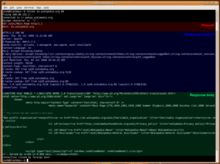OpenSSL could be made to expose sensitive information over the network, possibly including private keys.
Neel Mehta discovered that OpenSSL incorrectly handled memory in the TLS
heartbeat extension. An attacker could use this issue to obtain up to 64k
of memory contents from the client or server, possibly leading to the
disclosure of private keys and other sensitive information.
rails console vs irb
The exact prompt you'll see in irb can vary and I see the same one you do in Rails 3. It's nothing to worry about. In fact, I see the simple prompt in plain irb, and the full prompt in rails console :-)
They are both irb, it's just that rails console is set up such that the rails environment is all set and ready to work with, while regular irb has almost nothing loaded by default.
Controller
A controller is a Ruby class which inherits from ApplicationController and has methods just like any other class. When your application receives a request, the routing will determine which controller and action to run, then Rails creates an instance of that controller and runs the method with the same name as the action.Request methods
HTTP defines methods (sometimes referred to as verbs) to indicate the desired action to be performed on the identified resource. What this resource represents, whether pre-existing data or data that is generated dynamically, depends on the implementation of the server. Often, the resource corresponds to a file or the output of an executable residing on the server. The HTTP/1.0 specification[10]:section 8defined the GET, POST and HEAD methods and the HTTP/1.1 specification[1]:section 9 added 5 new methods: OPTIONS, PUT, DELETE, TRACE and CONNECT. By being specified in these documents their semantics are well known and can be depended upon. Any client can use any method and the server can be configured to support any combination of methods. If a method is unknown to an intermediate it will be treated as an unsafe and non-idempotent method. There is no limit to the number of methods that can be defined and this allows for future methods to be specified without breaking existing infrastructure. For example, WebDAV defined 7 new methods and RFC5789 specified the PATCH method.
- GET
- Requests a representation of the specified resource. Requests using GET should only retrieve data and should have no other effect. (This is also true of some other HTTP methods.)[1] The W3C has published guidance principles on this distinction, saying, "Web application design should be informed by the above principles, but also by the relevant limitations."[11] See safe methods below.
- HEAD
- Asks for the response identical to the one that would correspond to a GET request, but without the response body. This is useful for retrieving meta-information written in response headers, without having to transport the entire content.
- POST
- Requests that the server accept the entity enclosed in the request as a new subordinate of the web resource identified by the URI. The data POSTed might be, as examples, an annotation for existing resources; a message for a bulletin board, newsgroup, mailing list, or comment thread; a block of data that is the result of submitting a web form to a data-handling process; or an item to add to a database.[12]
- PUT
- Requests that the enclosed entity be stored under the supplied URI. If the URI refers to an already existing resource, it is modified; if the URI does not point to an existing resource, then the server can create the resource with that URI.[13]
- DELETE
- Deletes the specified resource.
- TRACE
- Echoes back the received request so that a client can see what (if any) changes or additions have been made by intermediate servers.
- OPTIONS
- Returns the HTTP methods that the server supports for the specified URL. This can be used to check the functionality of a web server by requesting '*' instead of a specific resource.
- CONNECT
- Converts the request connection to a transparent TCP/IP tunnel, usually to facilitate SSL-encrypted communication (HTTPS) through an unencrypted HTTP proxy.[14][15] See HTTP CONNECT Tunneling.
- PATCH
- Is used to apply partial modifications to a resource.[16]
HTTP servers are required to implement at least the GET and HEAD methods[17] and, whenever possible, also the OPTIONS method.[citation needed]
Resources
A resource is simply the object the user of the application will interact with.
Rails Tutorial Chapter 8.20
current_user=
First, you're reading the method names wrong (which is not surprising given how cryptic ruby method naming can be). def current_user=(user) is actually read as defining the method current_user= that takes an argument user, whereas def current_user defines a method current_user that takes no arguments. These are referred to respectively as setters and getters.Setters and getters are like attr accessor and attr reader.


No comments:
Post a Comment